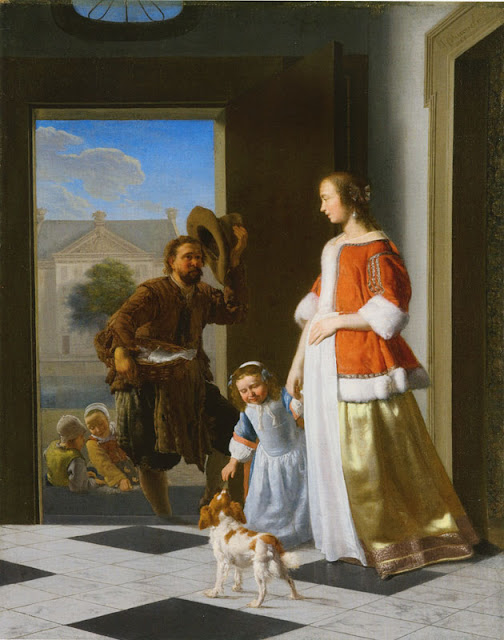I was so excited when I heard about this exhibition at the Fitzwilliam Museum, that I jumped out of my chair immediately and ran over to see it. Now before you think I am crazy, let me tell you that my department is next door to the museum. Not that I would have missed it if it were not, Vermeer has always been one of my favourite painters.
Having only studied about Vermeer’s paintings in books before, I was eager to see them in the flesh. And the exhibition did not disappoint, with a delightful theme and full of radiant masterpieces, Vermeer’s Women: Secrets and Silence had me rapt from the start.
While Vermeer’s name is being used to entice the crowds, only four of the 32 paintings are actually by him. The rest are by other Dutch master painters such as Gerard Ter Borch, Pieter de Hooch, Nicholas Maes and Jacobus Vrel. The exhibition brings together these masters under a brilliantly curated theme, concentrating on a significant era in Dutch paintings that featured scenes of 17th century women in their homes.
Having only studied about Vermeer’s paintings in books before, I was eager to see them in the flesh. And the exhibition did not disappoint, with a delightful theme and full of radiant masterpieces, Vermeer’s Women: Secrets and Silence had me rapt from the start.
While Vermeer’s name is being used to entice the crowds, only four of the 32 paintings are actually by him. The rest are by other Dutch master painters such as Gerard Ter Borch, Pieter de Hooch, Nicholas Maes and Jacobus Vrel. The exhibition brings together these masters under a brilliantly curated theme, concentrating on a significant era in Dutch paintings that featured scenes of 17th century women in their homes.
 |
Vermeer: A lady at the Virginals with a Gentleman |
In canvas after canvas, we see maidservants and their middle class mistresses performing seemingly mundane tasks: sewing, spinning, fetching water, scraping parsnips, breastfeeding and playing the virginal. The house is shown to be spick and span, reflecting the Dutch desire for cleanliness, order and harmony within the home.
But these mundane tasks take on a new meaning when we realize that these paintings depict the seldom seen intimacy of the Dutch household, a silent and often mysterious domestic realm, inhabited almost exclusively by women and children and closed to the outside world. In the 17th century this domestic privacy was highly protected, the houses even had a special front hall (voorhuis) where tradesmen brought their wares. Servant girls met them here and took selected items to the wife living in the personal spaces at the back. The painter invites us to take a glimpse inside the house via the half open door; patterns in the flooring and brickwork further lead our eyes inside the house.
 |
Samuel Van Hoogstraten: View of an Interior, c1658 |
These domestic scenes would have been the only way to see a woman in the private realm of her home. The artists’ relationship with their subjects varies from voyeurism to empathy to curious scrutiny and lends a strange excitement to these simple scenes.
 |
Jacob Ochtervelt: A Fishmonger at the Door c.1663 |
The star of the show is unquestionably Vermeer’s The Lacemaker, on loan from the Louvre, and displayed in Britain for the first time. Seeing this enigmatic painting in the context of works by Vermeer’s contemporaries only enhances its value.
.jpg) |
| The Lacemaker |
But the painting I liked the most was the Woman at the Window the eerie interior scene by Jacobus Vrel, in which a woman sits alone by an opaque, moonlit window to behold a lone child – or the ghost of a child – staring at her from the darkness outside. This painting can be interpreted in so many different ways that I can gaze at it for hours.
 |
Jacobus Vrel: Woman at a Window, Waving at a Girl, c. 1650 |
I also liked the The Courtyard in Delft by Pieter de Hooch – this painting tells a story through carefully detailed architecture as the decayed garden wall on the right contrasts with the well-preserved house on the left.
 |
Pieter de Hooch: The Courtyard of a House in Delft c.1658 |
All images courtesy of Fitzwilliam Museum and Yale Books


No comments:
Post a Comment